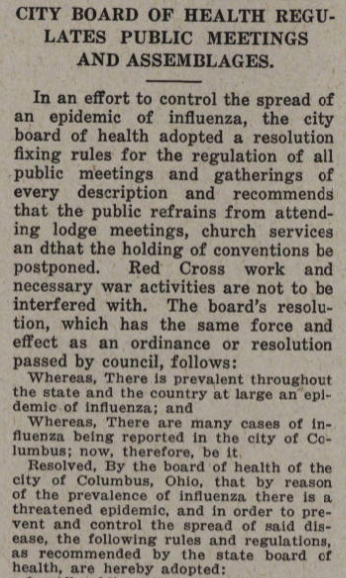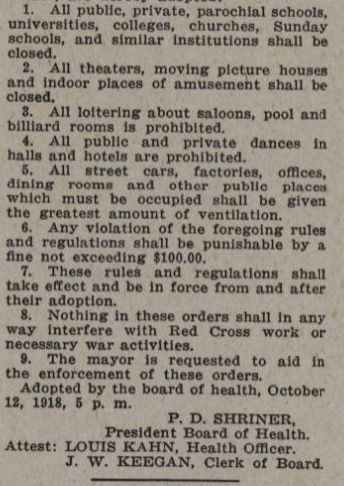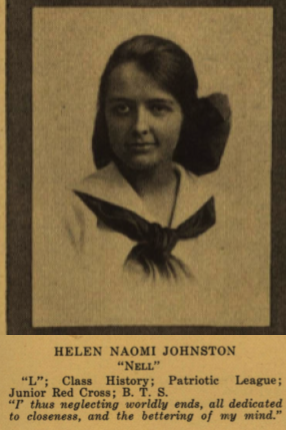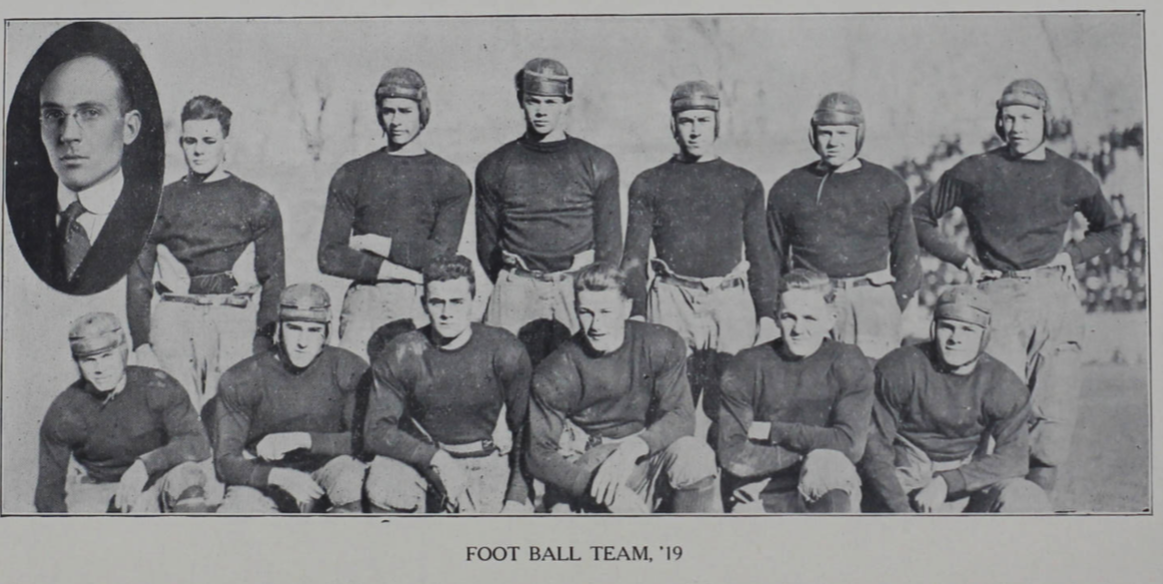|
PART 1. "WE TURNED OUR FOOTSTEPS HOMEWARD" by Matt Doran From 1918 to 1920, an influenza pandemic swept across the globe, resulting in an estimated 50 million deaths. The United States experienced about 675,000 influenza-related deaths. The most deadly period of the pandemic came during the second wave in the fall of 1918.[1] By the end of the second wave in January 1919, nearly 15,000 deaths in Ohio were attributed to influenza, with about 1,000 in Columbus.[2] The Chronology of a Closure To slow the spread of influenza, many cities across the United States began cancelling public gatherings and closing schools in early October. Ohio cities including Dayton, Marion, Salem, and Sidney ordered schools closed by October 9.[3] In Franklin County, East Columbus (then a separate city from Columbus) closed after 42 cases of influenza among its students. County School Superintendent William S. Coy also reported closed schools in Canal Winchester, Groveport, Madison Township, and Reynoldsburg by this date.[4]
School resumed in January, 1919 as the second wave came to an end, and remained opened for the remainder of the school year. Month-by-month, influenza claimed the lives of 320 Columbus residents in October, 246 in November, 251 in December, and 67 in January. After only 76 deaths in February, a brief spike led to 165 deaths in March, followed by 57 in April, 42 in May, and 12 in June.[14] The Class of 1919 Remembers High school yearbooks from the class of 1919 offer a glimpse of student reactions to school closures. Writing in West High School's The Occident, senior class officer Helen Johnston noted:
South High School’s "History of the Class of 1919" simply noted, “Interrupted by ‘flu’ vacations and independent vacations of our own we have managed to keep our studies and are being graduated with honor.”[17] North High School’s yearbook, The Polaris, celebrated the return of football season as classes resumed in November. On November 11, 1918 the Allies and Germany signed an armistice in France, ending the Great War. Meanwhile, on Ohio Field on the campus of the Ohio State University, North High School won 25-0 in a battle against Commerce High School. “After the ‘Flu’ epidemic had passed and the ban was lifted North and Commerce got together Monday morning, November 11, at Ohio Field. North’s squad showed needed pep and punch in carrying out plays. . . . Commerce put up a scrappy game on the defense, but when it came to team work on the offense, they were found sadly lacking in power. . . . The game was devoid of any thrills and showed lack of practice in both teams. . . ."[18] North High School football team from The Polaris yearbook, 1919 West High School also defeated South High School 20-0 on Ohio Field that day. The West yearbook summarized its season, “In-flu-enza and out-flew-football. With most of our out-of-town-dates cancelled because of the epidemic, the pigskin season settled into a race for local honors ....”[19] ENDNOTES
[1] Roser, Max. “The Spanish Flu (1918-20): The Global Impact of the Largest Influenza Pandemic in History.” Our World in Data. Global Change Data Lab, March 4, 2020. https://ourworldindata.org/spanish-flu-largest-influenza-pandemic-in-history [2] Kingseed, Wyatt. “From the Archives: Columbus Battles the Spanish Flu.” Columbus Monthly. March 30, 2020. https://www.columbusmonthly.com/news/20200330/from-archives-columbus-battles-spanish-flu [3] “Many County Schools Closed Because of Influenza Epidemic.” Columbus Evening Dispatch, October 9, 1918, 3. NewsBank: Access World News – Historical and Current. https://infoweb-newsbank-com.webproxy3.columbuslibrary.org/apps/news/document-view?p=WORLDNEWS&docref=image/v2%3A1467499E363272B3%40EANX-163B4A53E61F7621%402421876-163B48DBCB14BDF3%402 [4] Ibid. [5] “Danger of Influenza Epidemic is Remote,” Columbus Evening Dispatch, October 8, 1918, 8. https://infoweb-newsbank-com.webproxy3.columbuslibrary.org/apps/news/document-view?p=WORLDNEWS&docref=image/v2%3A1467499E363272B3%40EANX-163B4A530BAA27BB%402421875-1639EA9D4A9955BE%407 [6] Ibid. [7] “Influenza Encyclopedia.” Columbus, Ohio and the 1918-1919 Influenza Epidemic | The American Influenza Epidemic of 1918: A Digital Encyclopedia. University of Michigan Center for the History of Medicine, n.d. https://www.influenzaarchive.org/cities/city-columbus.html [8] Bethea, Jesse. “‘Columbus Is Surrounded’ - When Spanish Flu Infected Ohio.” ColumbusUnderground.com, March 25, 2020. https://www.columbusunderground.com/columbus-is-surrounded-when-spanish-flu-infected-ohio-jb1 [9] Seifert, Myron T. “Columbus Public School System Has a Singular Heritage.” My History. Columbus Metropolitan Library, n.d. https://digital-collections.columbuslibrary.org/digital/collection/memory/id/23774/rec/197 [10] “Schools Closed for Second Time by Health Board,” Columbus Evening Dispatch, December 3, 1918. 2 https://infoweb-newsbank-com.webproxy3.columbuslibrary.org/apps/news/document-view?p=WORLDNEWS&t=pubname%3A1467499E363272B3%21Columbus%2BDispatch/year%3A1918%211918/mody%3A1203%21December%2B03&action=browse&format=image&docref=image/v2%3A1467499E363272B3%40EANX-163BA756A561FD86%402421931-163B4A275D321520%400 [11] Ibid. [12] Ibid. [13] Ibid. [14] Hooper, Osman Castle. History of the City of Columbus, Ohio. Memorial Publishing, 1920. 273. https://www.google.com/books/edition/_/WjWfaxIi7zgC?hl=en [15] West High School, The Occident, (Columbus, OH: 1919), 4, Columbus Metropolitan Library, https://digital-collections.columbuslibrary.org/digital/collection/yearbook/id/28396 [16] Ibid. [17] South High School, The Annual, (Columbus, OH, 1919), 28, Columbus Metropolitan Library, https://digital-collections.columbuslibrary.org/digital/collection/yearbook/id/4375 [18] North High School, The Polaris, (Columbus: OH, 1919), 89, Columbus Metropolitan Library, https://digital-collections.columbuslibrary.org/digital/collection/yearbook/id/18374/rec/19 [19] The Occident, 1919, 69 https://digital-collections.columbuslibrary.org/digital/collection/yearbook/id/28473
1 Comment
Blackwell
5/9/2020 06:27:33 am
Nice article about the local history and impact of a virus.
Reply
Your comment will be posted after it is approved.
Leave a Reply. |
Archives
May 2020
Categories
All
|





 RSS Feed
RSS Feed
